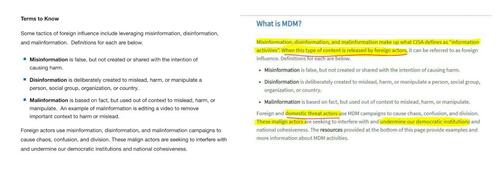
Authored by Matt Taibbi and Susan Schmidt via Racket News,
The Department of Homeland Security’s efforts to present a less Orwellian exterior to the public took a big step forward this week, as it disbanded a key subcommittee linked to the Department’s ill-fated Disinformation Governance Board, announced last year and quickly “paused” amid public outcry.
Jen Easterly, head of the DHS’s cyber division — the Cybersecurity and Infrastructure Security Agency, or CISA — this week convened the agency’s influential Cybersecurity Advisory Committee (CSAC), which is made up of senior executives from organizations like Twitter, Amazon, and the Stanford Internet Observatory. The agency announced an expanded roster, adding 13 new members to CSAC, including chief cybersecurity officer for General Motors Kevin Tierney and Cathy Lanier, the chief security officer for the NFL. The full CSAC now contains 34 members.
However, amid the additions, CISA also shuffled responsibilities, making a key change. In particular, its “MDM” advisory subcommittee, for “Misinformation, Disinformation and Malinformation,” was scrapped.
The subcommittee’s leaders, including chairperson Kate Starbird of the University of Washington’s Center for an Informed Public (CIP), and Vijaya Gadde, a former top Twitter executive who was fired last year when Elon Musk took over the company, were shifted to other advisory roles.
A spokesman for the agency said the change appeared in an unpublicized summary of a Dec. 6 advisory board meeting. The summary provided to Racket states Easterly decided late last year that the subcommittee had fulfilled its tasks and would “stand down”:
But that notice appears to have only been posted on the agency website recently (the Wayback Machine captured a first image of it in late February). CISA’s unique approach to website maintenance has drawn attention of late. Last week, Mike Benz of the Foundation for Freedom Online reported that CISA scrubbed key sections of its web page about its campaign against “Misinformation, Disinformation, and Malinformation.” Crucially, the agency appeared to remove references to “domestic threat actors” as purveyors of “MDM.”

The updated page now refers to foreign actors only, and no longer makes reference to other domestic-facing programs, like an “MDM planning and incident response guide for election officials.”
The changes come amid months of embarrassing #TwitterFiles disclosures about formal DHS involvement in the content moderation procedures of Twitter and other platforms. Two weeks ago, Michael Shellenberger of Public and the co-author of this article told a House Subcommittee about the “Censorship Industrial Complex,” among other things criticizing the “misinformation, disinformation, and malinformation” concept.
“MDM” was once central to CISA’s mission. In fact, it appeared to be the inspiration for the infamous Governance Board, which was designed to be a centralized hub uniting various public and private “anti-disinformation” initiatives. As reported by Lee Fang and Ken Klippenstein of The Intercept last October, Easterly in February of 2022 texted a former CISA official, saying she was “trying to get us in a place where Fed can work with platforms to better understand mis/dis trends so relevant agencies can try to prebunk/debunk as useful.”

It later came out that the DHS approved the creation of the Disinformation Governance Board on February 24, 2022. The charter for the new organization, which was announced to the public by DHS chief Alejandro Mayorkas on April 27, 2022 and slated to be headed by singing censor Nina Jankowicz, spoke to the agency’s growing obsession with stopping “MDM” at home:
DHS Disinformation Governance Board Charter
Section1. Purpose. The purpose of the Board is to support the Department’s efforts to address mis-, dis-, and mal-information (MDM), that threatens Homeland Security. Departmental components will lead on operational responses to MDM in their relevant mission spaces.
All of this came out after news of the Governance Board inspired a public flip-out, leading Republican Senators Chuck Grassley of Iowa and Josh Hawley of Missouri to send the DHS formal demands for information. The documents the DHS produced showed CISA envisioned a deepening of its partnership with Twitter. On April 28, the day after the Governance Board was announced, DHS Undersecretary Robert Silvers was scheduled to meet with Twitter Head of Policy Nick Pickles and Trust and Safety chief Yoel Roth.
A briefing memo prepared for Silvers by Jankowicz advised him to discuss “operationalizing public-private partnerships between DHS and Twitter.” Silvers was to line up Twitter’s coordination with the new board, and ask it to “become involved in Disinformation Governance Board Analytic Exchanges”:
The creation of the Disinformation Governance Board represented a remarkable shift in focus, away from foreign threats and toward the domestic population.
The MDM subcommittee had actually once been called the Countering Foreign Influence Task Force (CFITF). Throughout the period of the 2020 Election, Twitter received large quantities of flags about tweets from the CFITF, notices which appear in abundance in the #TwitterFiles. These letters often originated from a regional American agency, like the Secretary of State’s office in Colorado or Connecticut.
This was odd behavior for an agency devoted to countering “foreign” threats. The subcommittee subsequently changed its name and — briefly — adopted a more openly domestic focus.
Last June, the advisory board recommended that CISA should work with and provide support to external partners “who identify emergent informational threats,” and find ways to mitigate “false and misleading narratives.”
It also said CISA should fund and collaborate with partners to measure the impact of disinformation and mitigation, and do “proactive” work like “pre-bunking” emerging rumors. In a five-page memo of recommendations, the board listed a slew of aggressive ideas for combating “MD” at home (i.e. “mis- and disinformation”) that included “reducing engagement” by offenders:
The tasks were enormous, advisors said. “CISA should consider MD across the information ecosystem,” including talk radio, cable news, mainstream media, and “hyper-partisan media.”
Easterly’s response to the June recommendations focused on foreign threats. She narrowed the scope of a recommendation from the MDM subcommittee that the agency should combat mis- and disinformation that “undermines critical functions of American society and undermines response to emergencies.”
Easterly responded by saying CISA will continue to work on ways to counter “foreign influence operations and disinformation that threatens the integrity of the election infrastructure.” She seemed to agree that the agency should work with academic researchers to measure the impact of their efforts.
Meeting minutes from last year also show the public furor over the DHS announcement of a “Disinformation Governance Board” had MDM subcommittee members worried. They discussed delaying and toning down their June quarterly recommendations to the full CISA advisory board, with one passage suggesting members find a way to “pre-socialize” the existence of the subcommittee for key decision-makers:
[Redacted] suggested contacting Director Easterly in preparation for the rollout during the CSAC June Quarterly Meeting, to solicit her feedback on how to pre-socialize the existence of the subcommittee with key members of congress or outside validators.
Part of the subcommittee’s worry seemed to be that not many people knew what they were up to, or that they even existed — not in Congress or even at DHS. The group worried about how to “strategically approach MDM in the government in the current discourse.”
The “current discourse” was a reference to the furor over the Disinformation Governance Board, which by then was being likened to an Orwellian “Ministry of Truth.” After an outcry, Mayorkas had to “pause” its work and asked two top Washington lawyers, former DHS Secretary Mike Chertoff and former Deputy Attorney General Jamie Gorelick to weigh in on the legitimacy of the board. Within weeks the lawyers issued an urgent interim finding: It’s not needed.
They then issued a final report in August, affirming the Disinformation Board should be abolished. The report said government should limit its involvement with social media companies. DHS, they concluded, can bring disinformation to the attention of social media companies, but “it is for the platforms, alone, to determine whether any action is appropriate under their policies.”
Given the controversy over the Disinformation Governance Board, subcommittee members decided it would be better to jettison altogether a planned recommendation on “privacy and social listening,” which appeared to refer to the use of software that can proactively search out particular words or language. They worried this “most sensitive recommendation” could “overshadow other recommendations posed by the committee.”
The decision this week by CISA to scrap the MDM subcommittee, like last year’s “pause” of the governance board, reflects political sensitivity to growing public concern over social media censorship. What changes would more press attention bring?
Authored by Matt Taibbi and Susan Schmidt via Racket News,
The Department of Homeland Security’s efforts to present a less Orwellian exterior to the public took a big step forward this week, as it disbanded a key subcommittee linked to the Department’s ill-fated Disinformation Governance Board, announced last year and quickly “paused” amid public outcry.
Jen Easterly, head of the DHS’s cyber division — the Cybersecurity and Infrastructure Security Agency, or CISA — this week convened the agency’s influential Cybersecurity Advisory Committee (CSAC), which is made up of senior executives from organizations like Twitter, Amazon, and the Stanford Internet Observatory. The agency announced an expanded roster, adding 13 new members to CSAC, including chief cybersecurity officer for General Motors Kevin Tierney and Cathy Lanier, the chief security officer for the NFL. The full CSAC now contains 34 members.
However, amid the additions, CISA also shuffled responsibilities, making a key change. In particular, its “MDM” advisory subcommittee, for “Misinformation, Disinformation and Malinformation,” was scrapped.
The subcommittee’s leaders, including chairperson Kate Starbird of the University of Washington’s Center for an Informed Public (CIP), and Vijaya Gadde, a former top Twitter executive who was fired last year when Elon Musk took over the company, were shifted to other advisory roles.
A spokesman for the agency said the change appeared in an unpublicized summary of a Dec. 6 advisory board meeting. The summary provided to Racket states Easterly decided late last year that the subcommittee had fulfilled its tasks and would “stand down”:
But that notice appears to have only been posted on the agency website recently (the Wayback Machine captured a first image of it in late February). CISA’s unique approach to website maintenance has drawn attention of late. Last week, Mike Benz of the Foundation for Freedom Online reported that CISA scrubbed key sections of its web page about its campaign against “Misinformation, Disinformation, and Malinformation.” Crucially, the agency appeared to remove references to “domestic threat actors” as purveyors of “MDM.”

The updated page now refers to foreign actors only, and no longer makes reference to other domestic-facing programs, like an “MDM planning and incident response guide for election officials.”
The changes come amid months of embarrassing #TwitterFiles disclosures about formal DHS involvement in the content moderation procedures of Twitter and other platforms. Two weeks ago, Michael Shellenberger of Public and the co-author of this article told a House Subcommittee about the “Censorship Industrial Complex,” among other things criticizing the “misinformation, disinformation, and malinformation” concept.
“MDM” was once central to CISA’s mission. In fact, it appeared to be the inspiration for the infamous Governance Board, which was designed to be a centralized hub uniting various public and private “anti-disinformation” initiatives. As reported by Lee Fang and Ken Klippenstein of The Intercept last October, Easterly in February of 2022 texted a former CISA official, saying she was “trying to get us in a place where Fed can work with platforms to better understand mis/dis trends so relevant agencies can try to prebunk/debunk as useful.”

It later came out that the DHS approved the creation of the Disinformation Governance Board on February 24, 2022. The charter for the new organization, which was announced to the public by DHS chief Alejandro Mayorkas on April 27, 2022 and slated to be headed by singing censor Nina Jankowicz, spoke to the agency’s growing obsession with stopping “MDM” at home:
DHS Disinformation Governance Board Charter
Section1. Purpose. The purpose of the Board is to support the Department’s efforts to address mis-, dis-, and mal-information (MDM), that threatens Homeland Security. Departmental components will lead on operational responses to MDM in their relevant mission spaces.
All of this came out after news of the Governance Board inspired a public flip-out, leading Republican Senators Chuck Grassley of Iowa and Josh Hawley of Missouri to send the DHS formal demands for information. The documents the DHS produced showed CISA envisioned a deepening of its partnership with Twitter. On April 28, the day after the Governance Board was announced, DHS Undersecretary Robert Silvers was scheduled to meet with Twitter Head of Policy Nick Pickles and Trust and Safety chief Yoel Roth.
A briefing memo prepared for Silvers by Jankowicz advised him to discuss “operationalizing public-private partnerships between DHS and Twitter.” Silvers was to line up Twitter’s coordination with the new board, and ask it to “become involved in Disinformation Governance Board Analytic Exchanges”:
The creation of the Disinformation Governance Board represented a remarkable shift in focus, away from foreign threats and toward the domestic population.
The MDM subcommittee had actually once been called the Countering Foreign Influence Task Force (CFITF). Throughout the period of the 2020 Election, Twitter received large quantities of flags about tweets from the CFITF, notices which appear in abundance in the #TwitterFiles. These letters often originated from a regional American agency, like the Secretary of State’s office in Colorado or Connecticut.
This was odd behavior for an agency devoted to countering “foreign” threats. The subcommittee subsequently changed its name and — briefly — adopted a more openly domestic focus.
Last June, the advisory board recommended that CISA should work with and provide support to external partners “who identify emergent informational threats,” and find ways to mitigate “false and misleading narratives.”
It also said CISA should fund and collaborate with partners to measure the impact of disinformation and mitigation, and do “proactive” work like “pre-bunking” emerging rumors. In a five-page memo of recommendations, the board listed a slew of aggressive ideas for combating “MD” at home (i.e. “mis- and disinformation”) that included “reducing engagement” by offenders:
The tasks were enormous, advisors said. “CISA should consider MD across the information ecosystem,” including talk radio, cable news, mainstream media, and “hyper-partisan media.”
Easterly’s response to the June recommendations focused on foreign threats. She narrowed the scope of a recommendation from the MDM subcommittee that the agency should combat mis- and disinformation that “undermines critical functions of American society and undermines response to emergencies.”
Easterly responded by saying CISA will continue to work on ways to counter “foreign influence operations and disinformation that threatens the integrity of the election infrastructure.” She seemed to agree that the agency should work with academic researchers to measure the impact of their efforts.
Meeting minutes from last year also show the public furor over the DHS announcement of a “Disinformation Governance Board” had MDM subcommittee members worried. They discussed delaying and toning down their June quarterly recommendations to the full CISA advisory board, with one passage suggesting members find a way to “pre-socialize” the existence of the subcommittee for key decision-makers:
[Redacted] suggested contacting Director Easterly in preparation for the rollout during the CSAC June Quarterly Meeting, to solicit her feedback on how to pre-socialize the existence of the subcommittee with key members of congress or outside validators.
Part of the subcommittee’s worry seemed to be that not many people knew what they were up to, or that they even existed — not in Congress or even at DHS. The group worried about how to “strategically approach MDM in the government in the current discourse.”
The “current discourse” was a reference to the furor over the Disinformation Governance Board, which by then was being likened to an Orwellian “Ministry of Truth.” After an outcry, Mayorkas had to “pause” its work and asked two top Washington lawyers, former DHS Secretary Mike Chertoff and former Deputy Attorney General Jamie Gorelick to weigh in on the legitimacy of the board. Within weeks the lawyers issued an urgent interim finding: It’s not needed.
They then issued a final report in August, affirming the Disinformation Board should be abolished. The report said government should limit its involvement with social media companies. DHS, they concluded, can bring disinformation to the attention of social media companies, but “it is for the platforms, alone, to determine whether any action is appropriate under their policies.”
Given the controversy over the Disinformation Governance Board, subcommittee members decided it would be better to jettison altogether a planned recommendation on “privacy and social listening,” which appeared to refer to the use of software that can proactively search out particular words or language. They worried this “most sensitive recommendation” could “overshadow other recommendations posed by the committee.”
The decision this week by CISA to scrap the MDM subcommittee, like last year’s “pause” of the governance board, reflects political sensitivity to growing public concern over social media censorship. What changes would more press attention bring?
Loading…








